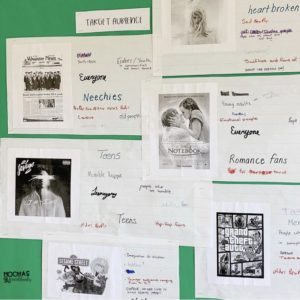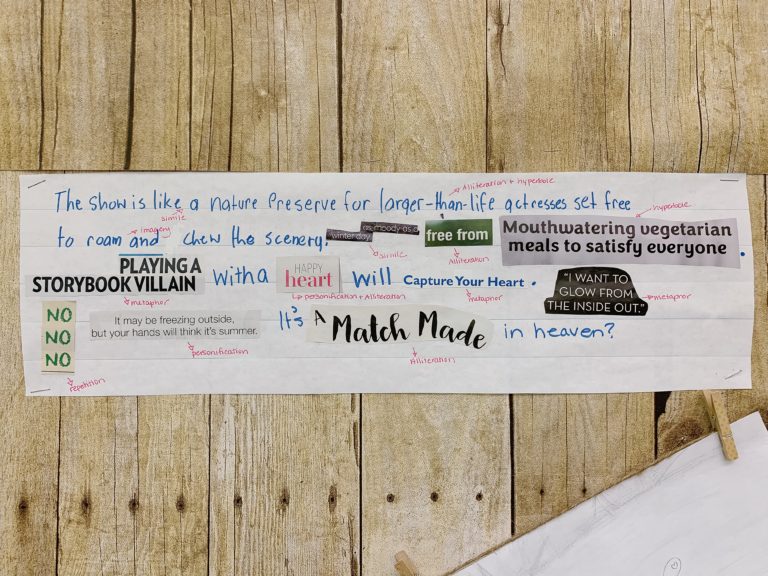15 Low Prep ELA Activities Using Magazines
Sharing is caring!

Are you even an English teacher if you don’t have a huge bin of old magazines in your classroom? Even though print media is declining, magazines are alive and well in English classrooms around the world thanks to tried and true activities like collages and found poetry, and in honour of this medium, I’ve compiled a list of 15 low prep magazine activities that have high impact and engagement.
Reading & Literature Activities
- Setting Sketch – Students find a picture from a magazine that has a similar setting to a story and cut it in half horizontally. Students draw the other half of the picture by hand to add in any details that were missed.
2. Collages – Students can create all kinds of collages to demonstrate comprehension of a text. Collages consist of cutting out words and images from magazines that relate to a specific theme, character, or story as a whole, and arranging and glueing them to a piece of paper. Collages can also serve as visual representations of information, such as showing the beginning, middle and end of a story, or how a character changes from beginning to end.
Non-Fiction Activities
3. Writing a News Report From a Snapshot – Students find a picture in a magazine, cut it out and glue it to a piece of paper. They create a headline that relates to the picture and then write a news report based around the picture and headline. Make sure to model this process for your students and engage in collaborative writing of a news report before having them complete individually.
4. Persuasive Writing – Identify examples of persuasive language used in magazine headlines, ads, and articles. Students can work individually or in groups to sort these examples into fact and opinion columns, then craft an opinion paragraph about whether they agree or disagree with one of the opinions they found.
Media Studies Activities
5. Identifying Target Audience – Attach various magazine covers to sheets of chart paper (real covers or printed from the Internet). Conduct a Graffiti activity by having students rotate through the chart paper stations to write who they feel is the target audience of each magazine around the cover (teenagers, music lovers, new parents, etc.). Then, present each paper and discuss the findings as a class.

6. Analyzing print advertisements – When teaching the elements of advertising, magazine print ads are a treasure trove for identifying headline, image, logo, slogan, claims, and persuasive language. Students can choose a print ad to cut or rip out, then glue to a piece of larger paper and label each element of advertising. You could also assign groups to cut out and create a collage of each element, then share with the class.
7. Representation Matters – Analyse magazines to determine who is represented and who is not represented in terms of race, culture, gender, sexual identity, body type, ability, etc. Students can recreate an advertisement or image from the magazine to include more diversity and inclusion.
8. Watch the Dove Evolution video and analyze magazine photos for effects like photoshop and airbrushing that might have occurred. You can show students magazine covers that have been accused of being photoshopped in this Cosmopolitan article here.
9. Creating Spoof Ads – Show students the spoof advertisements on the Adbusters site. Discuss what a spoof is, and what kinds of things companies can be spoofed or critiqued for. Discuss what print advertisements might look like if they told the complete truth. Students choose a print ad from a magazine and recreate it as a spoof ad that reveals a truth behind the product.
Creative Writing Activities
10. Found Poetry – A classic use for magazines in the classroom is found poetry. Students cut out words from magazines and arrange on the page before glueing down to create a poem with serious ransom note vibes.
11. Poetic Devices Collage – This is one of my favourite ways to kick off a poetry unit! After teaching poetic devices, I assign each student a device. They have to find an example of the device in a magazine and cut it out. Once everyone has cut out their device, they must work together to arrange and create a poem out of all of their finds. Adding connecting words with a marker is allowed to keep the flow of the poem. Once the poem is completed, display in the classroom as a reminder of poetic devices.

12. Creative Writing prompts – Break students into groups and have one group cut out a picture of a person from a magazine that looks interesting to them – this will be the main character of a story. Another group will cut out a picture to represent the setting of the story, and the last group will cut out a phrase to become the title of the story. Reveal the three images to the whole class and let them begin to write the story.
13. Imagery – Students find a picture in a magazine that has some scenery or background detail. Ask students to write all of the imagery details they would experience in that scene. You can provide students with an imagery chart to help with columns for sight, sound, smell, touch, taste. Students can then write a descriptive paragraph using their imagery details.
Word Work & Grammar Activities
14. Word Search – Give every student a magazine and randomly call different poetic devices, or parts of speech such as a prepositional phrase. The first student to find an example gets a point and the student that has the most points at the end of a predetermined amount of rounds wins.
15. Parts of speech Collage – Students can look for examples of adjectives or verbs in magazines to cut out and add to a class collage.
Leave a Reply Cancel reply
© Mochas and markbooks 2025 | Template by Waymaker Designs |
[…] are looking for other ways to incorporate collage and magazines into your post-reading assessments, check out this blog post for more […]